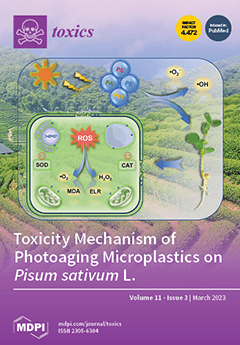Concentrations of heavy metals (HMs) were assessed in
Tilapia spp. from selected communities in Calapan City, Philippines. Eleven (11) inland farmed tilapia samples were collected and analyzed for HMs concentration using X-ray fluorescence (XRF). The 11 fish samples were cut into seven pieces,
[...] Read more.
Concentrations of heavy metals (HMs) were assessed in
Tilapia spp. from selected communities in Calapan City, Philippines. Eleven (11) inland farmed tilapia samples were collected and analyzed for HMs concentration using X-ray fluorescence (XRF). The 11 fish samples were cut into seven pieces, according to the fish body parts, constituting a total of 77 samples. These fish samples were then labeled as bone, fins, head, meat, skin, and viscera. Results showed that the mean concentration of Cd in all parts of tilapia exceeded the Food and Agriculture Organization/World Health Organization (FAO/WHO) limits. The highest concentration was recorded in the fins, which was sevenfold higher than the limit. The trend of the mean concentration of Cd in different parts of tilapia was fins > viscera > skin > tail > head > meat > bone. The target hazard quotient (
THQ) recorded a value less than 1. This means that the population exposed to tilapia, within the area where fish samples originated, were not at risk to non-carcinogens. The concentrations of Cu, Pb, Mn, Hg, and Zn in different parts, particularly in skin, fins, and viscera, also exceeded the FAO/WHO limits. The calculated cancer risk (
CR) in consuming the fish skin, meat, fins, bone, viscera, and head was higher than the USEPA limit. This indicated a possible carcinogenic risk when consumed regularly. Most of the correlations observed between HMs in various parts of the tilapia had positive (direct) relationships, which were attributed to the HM toxicity target organ characteristics. Results of the principal component analysis (PCA) showed that most of the dominating HMs recorded in tilapia were attributable to anthropogenic activities and natural weathering within the watershed of agricultural areas. The agriculture area comprises about 86.83% of the overall land area of Calapan City. The identified carcinogenic risks were associated with Cd. Therefore, regular monitoring of HMs in inland fishes, their habitat, and surface water quality shall be carried out. This information is useful in creating strategies in metals concentration monitoring, health risks reduction program, and relevant guidelines that would reduce the accumulation of HM in fish.
Full article






